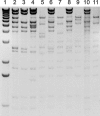pSK41-like plasmid is necessary for Inc18-like vanA plasmid transfer from Enterococcus faecalis to Staphylococcus aureus in vitro
- PMID: 23089754
- PMCID: PMC3535934
- DOI: 10.1128/AAC.01587-12
pSK41-like plasmid is necessary for Inc18-like vanA plasmid transfer from Enterococcus faecalis to Staphylococcus aureus in vitro
Abstract
Vancomycin-resistant Staphylococcus aureus (VRSA) is thought to result from the in vivo conjugative transfer of a vanA plasmid from an Enterococcus sp. to S. aureus. We studied bacterial isolates from VRSA cases that occurred in the United States to identify microbiological factors which may contribute to this plasmid transfer. First, vancomycin-susceptible, methicillin-resistant S. aureus (MRSA) isolates from five VRSA cases were tested for their ability to accept foreign DNA by conjugation in mating experiments with Enterococcus faecalis JH2-2 containing pAM378, a pheromone-response conjugative plasmid. All of the MRSA isolates accepted the plasmid DNA with similar transfer efficiencies (∼10(-7)/donor CFU) except for one isolate, MRSA8, for which conjugation was not successful. The MRSA isolates were also tested as recipients in mating experiments between an E. faecalis isolate with an Inc18-like vanA plasmid that was isolated from a VRSA case patient. Conjugative transfer was successful for 3/5 MRSA isolates. Successful MRSA recipients carried a pSK41-like plasmid, a staphylococcal conjugative plasmid, whereas the two unsuccessful MRSA recipients did not carry pSK41. The transfer of a pSK41-like plasmid from a successful MRSA recipient to the two unsuccessful recipients resulted in conjugal transfer of the Inc18-like vanA plasmid from E. faecalis at a frequency of 10(-7)/recipient CFU. In addition, conjugal transfer could be achieved for pSK41-negative MRSA in the presence of a cell-free culture filtrate from S. aureus carrying a pSK41-like plasmid at a frequency of 10(-8)/recipient CFU. These results indicated that a pSK41-like plasmid can facilitate the transfer of an Inc18-like vanA plasmid from E. faecalis to S. aureus, possibly via an extracellular factor produced by pSK41-carrying isolates.
Figures

References
-
- Zhu W, Murray PR, Huskins WC, Jernigan JA, McDonald LC, Clark NC, Anderson KF, McDougal LK, Hageman JC, Olsen-Rasmussen M, Frace M, Alangaden GJ, Chenoweth C, Zervos MJ, Robinson-Dunn B, Schreckenberger PC, Reller LB, Rudrik JT, Patel JB. 2010. Dissemination of an Enterococcus Inc18-like vanA plasmid associated with vancomycin-resistant Staphylococcus aureus. Antimicrob. Agents Chemother. 54:4314–4320 - PMC - PubMed
-
- Tiwari HK, Sen MR. 2006. Emergence of vancomycin resistant Staphylococcus aureus (VRSA) from a tertiary care hospital from northern part of India. BMC Infect. Dis. 6:156 doi:10.1186/1471-2334-6-156 - DOI - PMC - PubMed
-
- Aligholi M, Emaneini M, Jabalameli F, Shahsavan S, Dabiri H, Sedaght H. 2008. Emergence of high-level vancomycin-resistant Staphylococcus aureus in the Imam Khomeini Hospital in Tehran. Med. Principles Pract. 17:432–434 - PubMed
MeSH terms
Substances
LinkOut - more resources
Full Text Sources
Medical

